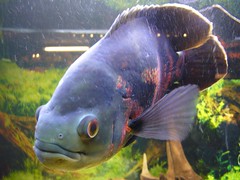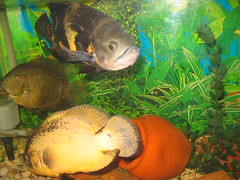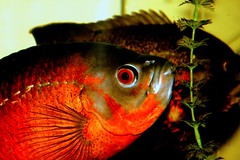 You have bought yourself a fish tank (aquarium) and you have got yourself the filtration system for it. Now what? Time to fill it up! Okay, there are plenty of information on the net on how you should condition the water in an aquarium and that you have to use all kinds of water treatment liquids to ensure that the water condition is just right before you introduce your Oscar fish into the aquarium. Trust me, having reared an Oscar successfully, it need not be so complicated.
You have bought yourself a fish tank (aquarium) and you have got yourself the filtration system for it. Now what? Time to fill it up! Okay, there are plenty of information on the net on how you should condition the water in an aquarium and that you have to use all kinds of water treatment liquids to ensure that the water condition is just right before you introduce your Oscar fish into the aquarium. Trust me, having reared an Oscar successfully, it need not be so complicated.Firstly, I placed the fish tank on sturdy stands. Usually the shop which sells you the tank would recommend a stand to go together with the tank. Then, I will set up the water filter and run the pipings according to instructions. If you wish to place gravel in the tank, rinse them before hand to remove dirt, dust and grime.
Next, place a plate or something flat on top of the bed of gravel before pouring water onto it. This will prevent the water from disturbing your latest landscape work of art. After you have filled up the tank with water (usually leave at least 3 inches between the water surface level and the top of the tank), turn on the water filter and let it run. The water might turn slightly cloudy as tiny particles in the gravel are mixed into the water. It is okay. The water should turn clear in a while.
Whilst letting the filter run, get a good anti-chlorine and add this into the water. I previously used the Genesis brand. Follow the instructions on the bottle. As the Oscar fish is pretty hardy, you don't really need stuff like ph-control unless your water source is seriously skewed towards extreme levels of acidity or alkalinity. You might, however, want to put in a couple of bio-bacteria drops which you can purchase from the aquarium store. This helps to start up the friendly bacterial colony in the water filter system. Allow the water to set itself up for about an hour or more before introducing your Oscar fish into the tank.
Now, don't just throw that Oscar into the water. Whilst the Oscar fish is still in its bag, float the bag over the water surface in the aquarium for at least 30 minutes. This allows the water in the bag (with the Oscar) to be brought nearer to the temperature of the water in the aquarium. You may release the Oscar fish after that. I usually only release my pet fish when it is dark. This helps to minimise the stress to the fish when it is introduced to a new environment - its new home!





